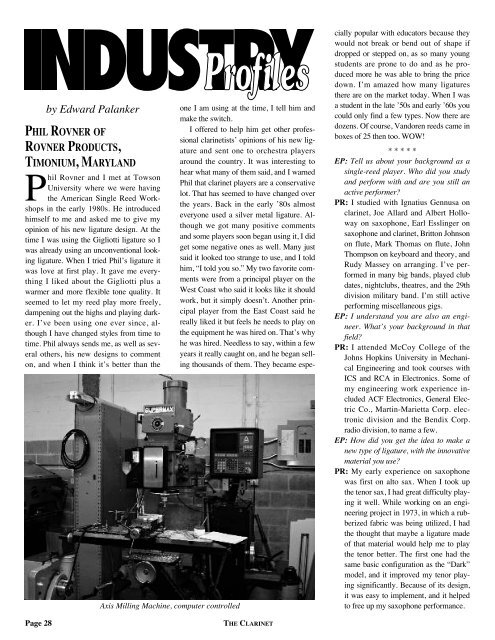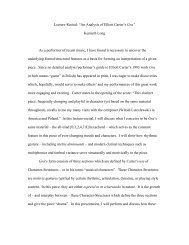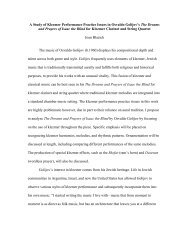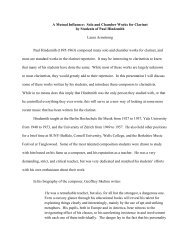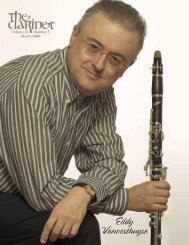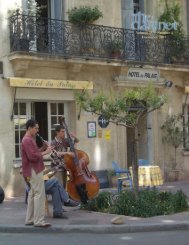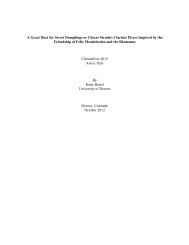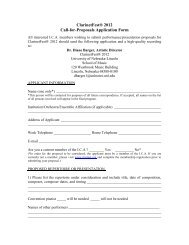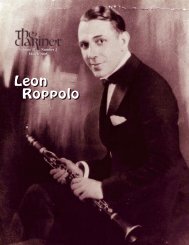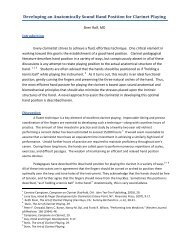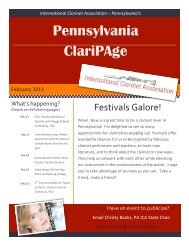Volume 33 Number 3 June 2006 - International Clarinet Association
Volume 33 Number 3 June 2006 - International Clarinet Association
Volume 33 Number 3 June 2006 - International Clarinet Association
- No tags were found...
Create successful ePaper yourself
Turn your PDF publications into a flip-book with our unique Google optimized e-Paper software.
y Edward Palanker<br />
PHIL ROVNER OF<br />
ROVNER PRODUCTS,<br />
TIMONIUM, MARYLAND<br />
Phil Rovner and I met at Towson<br />
University where we were having<br />
the American Single Reed Work -<br />
shops in the early 1980s. He introduced<br />
himself to me and asked me to give my<br />
opinion of his new ligature design. At the<br />
time I was using the Gigliotti ligature so I<br />
was already using an unconventional looking<br />
ligature. When I tried Phil’s ligature it<br />
was love at first play. It gave me everything<br />
I liked about the Gigliotti plus a<br />
warmer and more flexible tone quality. It<br />
seemed to let my reed play more freely,<br />
dampening out the highs and playing darker.<br />
I’ve been using one ever since, al -<br />
though I have changed styles from time to<br />
time. Phil always sends me, as well as several<br />
others, his new designs to comment<br />
on, and when I think it’s better than the<br />
Axis Milling Machine, computer controlled<br />
one I am using at the time, I tell him and<br />
make the switch.<br />
I offered to help him get other professional<br />
clarinetists’ opinions of his new ligature<br />
and sent one to orchestra players<br />
around the country. It was interesting to<br />
hear what many of them said, and I warned<br />
Phil that clarinet players are a conservative<br />
lot. That has seemed to have changed over<br />
the years. Back in the early ’80s almost<br />
everyone used a silver metal ligature. Al -<br />
though we got many positive comments<br />
and some players soon began using it, I did<br />
get some negative ones as well. Many just<br />
said it looked too strange to use, and I told<br />
him, “I told you so.” My two favorite comments<br />
were from a principal player on the<br />
West Coast who said it looks like it should<br />
work, but it simply doesn’t. Another principal<br />
player from the East Coast said he<br />
really liked it but feels he needs to play on<br />
the equipment he was hired on. That’s why<br />
he was hired. Needless to say, within a few<br />
years it really caught on, and he began selling<br />
thousands of them. They became especially<br />
popular with educators because they<br />
would not break or bend out of shape if<br />
dropped or stepped on, as so many young<br />
students are prone to do and as he produced<br />
more he was able to bring the price<br />
down. I’m amazed how many ligatures<br />
there are on the market today. When I was<br />
a student in the late ’50s and early ’60s you<br />
could only find a few types. Now there are<br />
dozens. Of course, Van doren reeds came in<br />
boxes of 25 then too. WOW!<br />
* * * * *<br />
EP: Tell us about your background as a<br />
single-reed player. Who did you study<br />
and perform with and are you still an<br />
active performer<br />
PR: I studied with Ignatius Gennusa on<br />
clarinet, Joe Allard and Albert Hollo -<br />
way on saxophone, Earl Esslinger on<br />
saxophone and clarinet, Britton Johnson<br />
on flute, Mark Thomas on flute, John<br />
Thompson on keyboard and theory, and<br />
Rudy Massey on arranging. I’ve performed<br />
in many big bands, played club<br />
dates, nightclubs, theatres, and the 29th<br />
division military band. I’m still active<br />
performing miscellaneous gigs.<br />
EP: I understand you are also an engineer.<br />
What’s your background in that<br />
field<br />
PR: I attended McCoy College of the<br />
Johns Hopkins University in Mechan i -<br />
cal Engineering and took courses with<br />
ICS and RCA in Electronics. Some of<br />
my engineering work experience in -<br />
clud ed ACF Electronics, General Elec -<br />
tric Co., Martin-Marietta Corp. electronic<br />
division and the Bendix Corp.<br />
radio division, to name a few.<br />
EP: How did you get the idea to make a<br />
new type of ligature, with the innovative<br />
material you use<br />
PR: My early experience on saxophone<br />
was first on alto sax. When I took up<br />
the tenor sax, I had great difficulty playing<br />
it well. While working on an engineering<br />
project in 1973, in which a rubberized<br />
fabric was being utilized, I had<br />
the thought that maybe a ligature made<br />
of that material would help me to play<br />
the tenor better. The first one had the<br />
same basic configuration as the “Dark”<br />
model, and it improved my tenor playing<br />
significantly. Because of its design,<br />
it was easy to implement, and it helped<br />
to free up my saxophone performance.<br />
Page 28<br />
THE CLARINET


